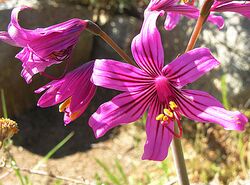Biology:Traubiinae
| Traubiinae | |
|---|---|

| |
| Placea amoena | |
| Scientific classification Error creating thumbnail: Unable to save thumbnail to destination
| |
| Kingdom: | Plantae |
| Clade: | Tracheophytes |
| Clade: | Angiosperms |
| Clade: | Monocots |
| Order: | Asparagales |
| Family: | Amaryllidaceae |
| Subfamily: | Amaryllidoideae |
| Tribe: | Hippeastreae |
| Subtribe: | Traubiinae D.Müll.-Doblies & U.Müll.-Doblies |
| Type genus | |
| Traubia Moldenke
| |
| Genera | |
|
See text | |
| Synonyms | |
|
Traubieae | |
thumb|Phycella cyrtanthoides''
Traubiinae is a subtribe of plants classified under the tribe Hippeastreae. It belongs to the subfamily Amaryllidoideae of the Amaryllis family (Amaryllidaceae).
Description
Bulbous perennial herbaceous plants, terrestrial in habitat. Leaves linear or lorate, annual, sometimes hysteranthous.
Taxonomy
The term was originally used by the Müller-Doblies'[1] in 1996 as a monotypic subtribe of Hippeastreae, to include Traubia, based on Traub's original use of Traubeae for the same purpose.[2]
Created from a redistribution of genera of Hippeastreae following a molecular phylogenetic study[3] it is composed of the following genera, based on the presence of lorate-leaves rather than petiolate, which form the remaining genera of the tribe Hippeastreae, i.e. Hippeastrinae. In this redistribution the four species of Famatina were polyphyletic and F. maulensis segregated with Phycella and was consequently transferred:[4][5]
The generic distribution here is based on Garcia et al 2019.[6]
- [Placea previous genus]
- Phycella (~13 species)
- Rhodolirium (2 species)
- Traubia (monotypic for T. modesta)
- Paposoa (monotypic for P. laetum)
The tribe Hippeastreae underwent a major recircumscription in 2019 and 2020. As a result a new genus, Eremolirion Nic.García (for Rhodolirium laetum and monotypic as Eremolirion laetum), leaving a more restricted Rhodolirium s. str.. In addition, Placea was absorbed into Phycella. The genus name Eremolirion was subsequently changed to Paposoa to avoid confusion with Eremiolirion.[6]
References
Bibliography
- García Berguecio, Nicolás (2015) (PhD Thesis). Systematics and evolution of Amaryllidaceae tribe Hippeastreae (Asparagales). University of Florida. http://www.iapt-taxon.org/downloads/grants/Garcia_Report_2013.pdf.
- Traub, H.P. (1963). Genera of the Amaryllidaceae. La Jolla, California: American Plant Life Society.
- García, Nicolás; Meerow, Alan W.; Soltis, Douglas E.; Soltis, Pamela S. (1 March 2014). "Testing Deep Reticulate Evolution in Amaryllidaceae Tribe Hippeastreae (Asparagales) with ITS and Chloroplast Sequence Data". Systematic Botany 39 (1): 75–89. doi:10.1600/036364414X678099.
- García, Nicolás; Meerow, Alan W.; Arroyo‐Leuenberger, Silvia; Oliveira, Renata S.; Dutilh, Julie H.; Soltis, Pamela S.; Judd, Walter S. (June 2019). "Generic classification of Amaryllidaceae tribe Hippeastreae". Taxon 68 (3): 481–498. doi:10.1002/tax.12062.(With corrections published 2020)
- Meerow, A.W.; Fay, M.F.; Guy, C.L.; Li, Q.-B.; Zaman, F.Q.; Chase, M.W. (1999). "Systematics of Amaryllidaceae based on cladistic analysis of plastid rbcL and trnL-F sequence data". Am. J. Bot. 86 (9): 1325–1345. doi:10.2307/2656780. PMID 10487820.
- Meerow, A.W.; Guy, C.L.; Li, Q.-B.; Yang, S.-L. (2000). "Phylogeny of the American Amaryllidaceae Based on nrDNA ITS Sequences". Systematic Botany 25 (4): 708–726. doi:10.2307/2666729. http://www.bulbsociety.org/meerow/Meerow%20et%20al-American.pdf. Retrieved 25 January 2015.
- Müller-Doblies, U.; Müller-Doblies, D. (1996). "Tribes and subtribes and some species combinations in Amaryllidaceae J St Hil R Dahlgren & al. 1985". Feddes Repertorium 107 (5–6): S.c.1–S.c.9.
- Urbina-Casanova, Rafael; Saldivia, Patricio; Scherson, Rosa A. (December 2015). "Consideraciones sobre la sistemática de las familias y los géneros de plantas vasculares endémicos de Chile" (in es). Gayana. Botánica 72 (2): 272–295. doi:10.4067/S0717-66432015000200011.
- Vigneron, Pascal (2008). "Amaryllidaceae" (in fr). http://www.amaryllidaceae.org//index.htm.
Wikidata ☰ Q22917103 entry
 |

